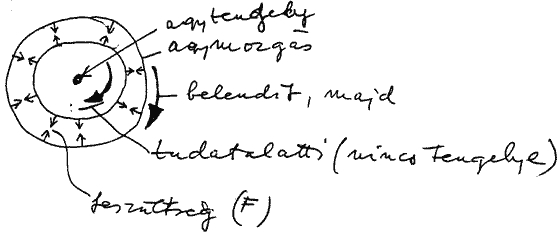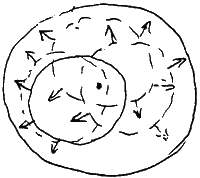On Art 1968-91 |
Painting I. 1966-70 |
How It All Started 1968-71 |
Signs [Modules] 1971-79
Conceptual works 1973-82 |
The Ego Problem 1973-76 |
Objectworks 1974-93
Painting II. 1984-89 |
Sound Sculptures 1974-91 |
Performance 1972-92
Technical Images 1974-92 |
Space Works 1970-93 |
Network/Institutions 1970-93
March 5, 1973
I can become aware only of things I've left behind but I can leave behind only things I'm aware of.
E= emotionally created
T= Conscious
S= latitudinal component (may be SM, latitude and depth)
Structural outline of the “Magic Steps“
Three-dimensional
S-T interdependency
Dynamic component
Height and latitudinal component
March 5, 1973
A mirror is but a form of perception, of control, a form of feedback.
PRINCIPLE OF DOUBLE REFLECTION
Dimension: infinite (this is the absolute simplification of the theory)
The “mirror” is only a tool to helps us learn who we are.The formula, therefore, can be applied to any point in an infinite continuum, with only the correlation remaining constant. (The function.)
Reality is always at a given point and not in general.
March 5, 1973
The principle of operation of the “Chocolate Mill”
(figure1)
(figure2)
October 17, 1973
What is it that allows me to do a number of different things without any detriment to my basic activity?
Let's see what happens in the psyche:
* The structure of the thinking process
1. basic activity
2. applied (direct)
3. applied (indirect)
4. isolated
1' professional standard
One must become aware of its place and role, and the dimensions of the task.
October 17, 1973
In order to escape a constant state of subjectivity, I must, from time to time, free myself from my work, and understand others. This requires a different mechanism of thought, but enables me to return to my earlier self as an outside observer.
December, 1973
The best thing, I believe, is to exercise my BRAIN, then to let it take off, while I keep it under constant control.

The F factor is the control, therefore the subconscious-which has no core-seemingly adopts the cerebral core as its own core, and acquires logic.

Brain movement may expand, stress may ease, etc., thus the subconscious will be allowed to emerge.
November 3, 1974
Theme: the victim.
I burn a photograph of myself (i.e. not myself).
I document my action.
Think about the connection between behavior and gesture.
Quotes:
John Ruskin: “Of greatest moral value in an artist: devotion to the ideal, and severity with himself.”.
Giovanni Vincenzo Gravina: “A man who is full of ambition or is a slave to his emotions is, for all practical purposes, insane, for his passions fill his soul, and leave no room for moderating or guiding principles.”
January 11, 1976
The everyday forms of anger and outrage cannot adequately motivate the solution
of an artistic problem.
“Inner”, refined emotions can.
1976
Quote
“The essence of intellectual production lies in man's recognizing the limits of his activity, and in knowing where those limits are; he can create wonderful things within these limits,
if he makes the most of his opportunities.” (Arnold Hauser)
Exhibition (The EGO problem)
I realize myself by destroying my own image. My self-realization is the destruction of my own image.
EGO-FACE 1973-1976
SUMMARY
Antecedent 1.: It was in 1973, at Balatonboglár, that the reflection and transparency of a pane
of glass provided the first natural opportunity. Placed on top of a photograph of a face,
it distorted the image to various degrees, depending on the angle from which we
looked at it.
Antecedent 2.: The next work of mine pointing in the same direction was something I did in 1975. It was called Window-Mirror. (I used a mercury-plated automobile windshield, and the person sitting inside could look at himself in the bent mirror of the glass.)
In 1975, I took my picture in a photo automat for one of my identity cards. Several of my friends remarked on the impersonality of the picture. I decided to enlarge the picture, and try, using a variety of different photomechanical means, to arrive at the picture's original meaning. I used traditional screens and every imaginable and available modifying device.
I selected the devices according to the variety of modifications they were capable of. As a last resort, I treated the original photograph itself as a modifying device.
The conceptual core of the procedure I found, in effect, in the relationship between man and machine.
The purpose of the modification: a portrait developed from the interaction of reality components in an object-concept relationship.
The method of modification: the addition or substraction of two superimposed pictures, one being the constant and the other being the modifier. The result was a face which could function either as the constant or the modifier in the next procedure.
Portraits that could be modified no further I considered as facts, or, if you will, as objets trouvés, and I printed them in sequence, as one would treat a collection. There came into being the sequence of possible portrait-variations, a sequence suited for indefinite expansion.
The individual portraits represent the different variants of the personality.
By reproducing a photo reduced to a size appropriate for a pattern, one can produce patterns suited for wallpapers, tablecloths or other household objects. The future of the pattern transformed into a household objects is determined by the use to which it is put; this is what motivates any further transformations.
The motives of this transformation will, in effect, furnish new perspectives on the portraits that constitute the motif. The head motif will be further modified by manual intervention (tearing, blowing, burning, etc.), until it disappears completely.
In the next phase, the modification of the original machine photo (the artist's self-modification) takes a new direction. The picture is enlarged into huge (3x4m) transparencies and is set in a variety of landscapes, where it takes on entirely different meanings.
The photographic documents of this action finally end up as postal stamps in the “Art & Reality - Selfpost” (1979-95) series, just as the first portrait series ended up on the pages of “Postflux-Fluxpost” (1980)
“As we turn the pages, the self-portrait itself retains less and less of its personal, self-expressing quality. It becomes the basic unit of a system of modules, a system suited for use in a variety of mechanical processes; at times, it seems to disappear entirely, so that only its absence is perceptible throughout. The principal player in this exercise in graphic modification, thus, is not some kind of motif, but the procedure itself, or, more precisely, its two prime devices: the photo negative, which essentially determined the image structure, and the fine silk-screen allowing or blocking the penetration of the dye.” (László Beke, 1978)
On Art 1968-91 |
Painting I. 1966-70 |
How It All Started 1968-71 |
Signs [Modules] 1971-79
Conceptual works 1973-82 |
The Ego Problem 1973-76 |
Objectworks 1974-93
Painting II. 1984-89 |
Sound Sculptures 1974-91 |
Performance 1972-92
Technical Images 1974-92 |
Space Works 1970-93 |
Network/Institutions 1970-93